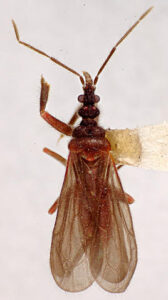The Heteroptera, commonly called true bugs, are one of four suborders in the order Hemiptera. They are one of the most diverse groups of hemimetabolous insects, comprising more than 45,000 species in 91 families worldwide. The suborder is divided into seven infraorders, one of which is aquatic (Nepomorpha), one semiaquatic (Gerromorpha), one riparian (Leptopodomorpha), and the remaining four terrestrial (Enicocephalomorpha, Dipsocoromorpha, Cimicomorpha, and Penatatomomorpha). True bugs are characterized by the wings lying flat over the body, with the forewings partially sclerotized and partially membranous, a piercing-sucking labium that arises anteriorly on the head, four- to five-segmented antennae, a large well-developed scutellum, paired metathoracic scent glands in adults, and dorsal abdominal scent glands in immatures, among other characters.
True bugs fall into two broad feedings regimes, plant feeders and predators. The phytophagous taxa are responsible for billions of dollars worth of damage to crops each year. The zoophagous species on the other hand are considered beneficial and may be of great value in biological control programs. A few groups that feed on vertebrate blood may transmit disease-causing pathogens, and certain aquatic species are known for their importance as water-quality indicators. The overall influence of this taxonomically complex suborder is enormous, making it one of the most important groups of insects on our planet.



